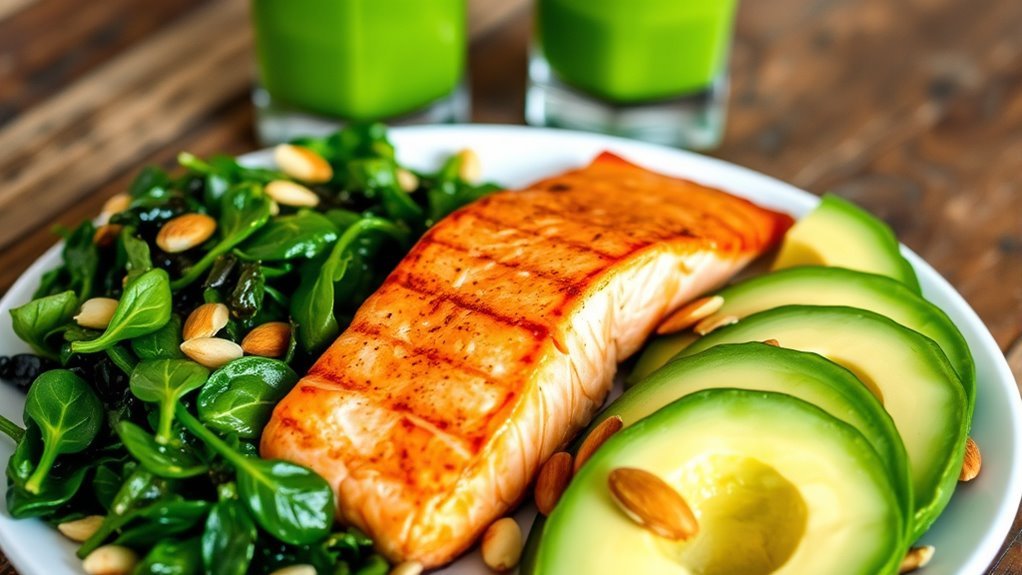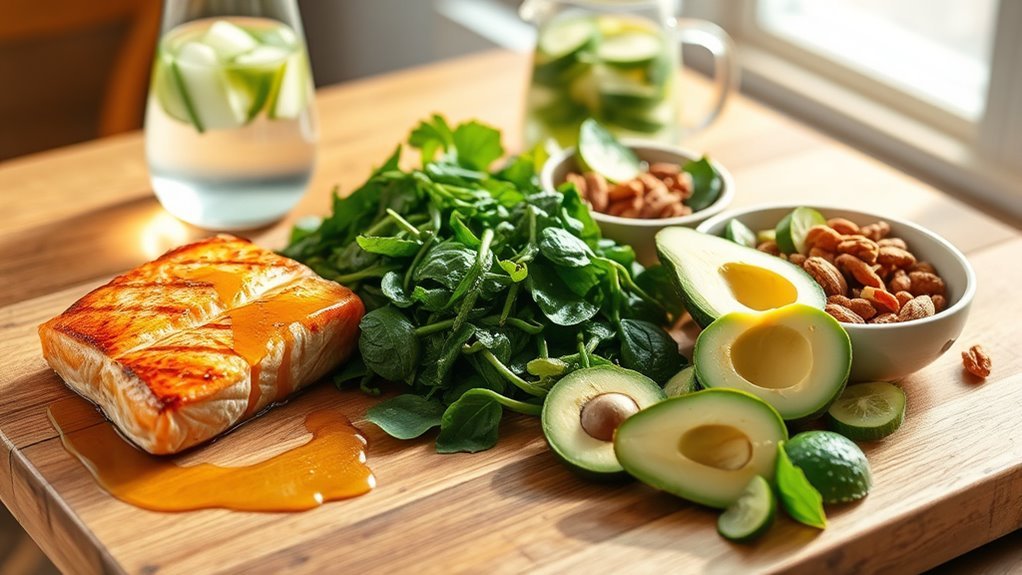To do a keto diet, you’ll need to drastically cut carbs to about 5-10% of your total calories while increasing healthy fats to 70-75%. Incorporate foods like avocados, nuts, and lean meats, and avoid processed foods and hidden sugars. Tracking your macronutrient intake is essential to maintain ketosis. Meal planning and batch cooking can help keep you organized and committed. There’s a lot more to discover about successfully maintaining this lifestyle, so let’s explore further!
Understanding the Ketogenic Diet

Understanding the ketogenic diet can seem overwhelming at first, but breaking it down into its core components makes it much simpler. At its heart, the ketogenic principles focus on drastically reducing carbohydrate intake while increasing healthy fats. This shift encourages your body to enter a state of ketosis, where it burns fat for fuel instead of glucose. Many people experience significant health benefits, such as improved energy levels, weight loss, and enhanced mental clarity. Additionally, studies suggest that the ketogenic diet may help manage conditions like epilepsy, diabetes, and certain metabolic disorders. By grasping these foundational elements, you empower yourself to embrace the keto lifestyle, releasing the freedom to optimize your health and wellbeing.
Macronutrient Ratios Explained

To successfully follow a ketogenic diet, grasping the macronutrient ratios is key. Achieving the right macronutrient balance helps you enter and maintain ketosis, allowing your body to burn fat for fuel. Typically, your daily intake should focus on:
- Fat: 70-75% of total calories
- Protein: 20-25% of total calories
- Carbohydrates: 5-10% of total calories
These ratios may require keto adjustments based on individual needs, activity levels, and health goals. Monitoring your intake and making necessary tweaks guarantees you stay aligned with your ketogenic objectives. Emphasizing this balance not only enhances weight loss but also supports overall health, empowering you to thrive on your keto journey while enjoying the freedom to choose your meals wisely.
Foods to Include in Your Keto Diet

When starting on a keto diet, it’s crucial to know which foods will support your journey toward ketosis. Focus on high-fat, low-carb options. Incorporate healthy fats like avocados, olive oil, and nuts, which provide sustained energy. For protein, lean meats, fish, and eggs are excellent choices. Don’t overlook dairy options; full-fat cheese, heavy cream, and Greek yogurt not only fit the macros but also add flavor and variety to your meals. For quick bites, consider keto snack ideas like jerky, nut butter, or celery with cream cheese. These foods will help keep you satisfied while maintaining your carb limits. Embracing these options allows you to enjoy your meals and remain committed to your keto lifestyle.
Foods to Avoid on a Keto Diet
While starting a keto diet, it’s important to steer clear of certain foods that can hinder your progress toward ketosis. Here are some common mistakes to watch out for:
Avoiding certain foods is crucial for achieving ketosis on a keto diet. Stay informed to prevent common pitfalls.
- Processed foods: These often contain hidden sugars and unhealthy fats that can disrupt ketosis.
- Carb alternatives: Many substitutes, like certain grains, still pack in carbs and should be avoided.
- Snack options: Beware of snacks that seem keto-friendly but are loaded with hidden sugars.
- Alcohol choices: Some beverages can have surprising carb content, so choose wisely when dining out.
Meal Planning for Keto Success
To achieve success on a keto diet, effective meal planning is vital. Start by creating an essential food list that aligns with your dietary goals, focusing on low-carb, high-fat options. Additionally, implementing a weekly meal prep routine can help you stay organized and committed to your keto lifestyle.
Essential Food List
Although starting on a keto diet can be challenging, having an essential food list at your disposal simplifies meal planning and sets you up for success. Here are some key items to stock your kitchen with:
- Healthy fats: Avocado oil, olive oil, coconut oil
- Protein sources: Grass-fed beef, chicken, fatty fish
- Low-carb veggies: Spinach, broccoli, cauliflower
- Keto snack options: Nuts, cheese, beef jerky
Equipping your kitchen with these essential tools will streamline your cooking process, allowing you the freedom to explore delicious recipes. By focusing on these staples, you’ll make it easier to stick to your keto lifestyle while enjoying a variety of nutritious meals. So, embrace this essential food list and kickstart your keto journey with confidence!
Weekly Meal Prep
Having a well-stocked kitchen makes it easier to plan your meals for the week ahead, which is essential for maintaining a keto diet. For effective keto meal prep, focus on batch cooking your favorite low-carb dishes. Preparing meals in advance not only saves time but also helps you avoid unhealthy temptations. Start by selecting recipes that align with your dietary goals, such as cauliflower rice stir-fries or zucchini noodles with creamy sauces. Cook large portions and store them in portioned containers, ensuring you have balanced meals ready to go. Don’t forget to incorporate healthy fats, proteins, and plenty of greens. With thoughtful planning and batch cooking, you’ll enjoy the freedom of sticking to your keto lifestyle effortlessly.
Tips for Grocery Shopping on Keto
When grocery shopping on a keto diet, focusing on whole foods is essential for maintaining your nutritional goals. Fresh vegetables, lean proteins, and healthy fats should be your primary staples. Additionally, always read nutrition labels carefully to guarantee you’re avoiding hidden sugars and carbs that can derail your progress.
Focus on Whole Foods
Embracing whole foods is essential for anyone following a keto diet, as these nutrient-dense options can help you achieve and maintain ketosis. Whole foods offer significant benefits, including higher nutrient density and fewer additives. When grocery shopping, consider these tips:
- Prioritize fresh vegetables like leafy greens and cruciferous options.
- Choose high-quality proteins such as grass-fed meat and wild-caught fish.
- Incorporate healthy fats like avocados, nuts, and olive oil.
- Avoid processed foods, which often contain hidden sugars and unhealthy fats.
Read Nutrition Labels
As you navigate the grocery aisles on your keto journey, reading nutrition labels becomes an essential skill for making informed choices. Start by focusing on label comprehension; familiarize yourself with serving sizes, as they can greatly affect your net carbs and calorie counting. Look for hidden sugars often disguised under various names in the ingredients list. Pay close attention to nutritional values, particularly dietary fibers and sodium content. Understanding how these elements interact can help you maintain portion control and stay within your carb limits. Remember, not all products labeled “low-carb” are created equal. By mastering these skills, you empower yourself to make choices that align with your keto goals while enjoying the freedom of a varied diet.
Overcoming Common Keto Challenges
Steering through the keto diet can present several challenges, but understanding these hurdles is the first step toward overcoming them. You might face keto cravings, struggle with energy levels, or find it tough to maintain meal variety, especially in social situations. Here are some strategies to help you stay on track:
Navigating the keto diet can be challenging, but recognizing these obstacles is key to your success.
- Adapting recipes for family meals can make them keto-friendly.
- Exploring snack options that satisfy cravings without derailing your progress.
- Finding motivation tips to keep your spirits high during plateaus.
- Planning for eating out by checking menus in advance.
How to Track Your Progress
Tracking your progress on a keto diet is essential for staying motivated and ensuring you’re on the right path. Start by establishing clear goal setting with specific progress indicators, such as weight measurements and body composition changes. Utilize fitness tracking apps to monitor these metrics regularly. Journaling methods can help you reflect on your daily intake and emotional responses, enhancing your awareness. Consider taking progress photos to visually document your transformation. Additionally, keep an eye on health markers like blood glucose levels and ketone production, which can provide valuable insights. Finally, having accountability partners can enhance your commitment and support as you navigate your journey, making it easier to stay on track and celebrate milestones.
Keto-Friendly Recipes to Try
When you commence on a keto diet, finding delicious and satisfying recipes can make all the difference in maintaining your commitment. Here are some great ideas to keep your meals exciting and aligned with your goals:
- Keto breakfast ideas: Try avocado and eggs or a chia seed pudding for a nutritious start.
- Easy keto snacks: Cheese crisps or celery with cream cheese are perfect for between meals.
- Quick keto lunches: Opt for lettuce wraps filled with turkey and cheese for a satisfying option.
- Flavorful keto dinners: One pan keto meals like roasted chicken with vegetables simplify cooking and cleanup.
Don’t forget to explore keto dessert options and keto-friendly smoothies to satisfy your sweet tooth while staying on track!
Maintaining Your Keto Lifestyle Long-Term
To maintain your keto lifestyle long-term, effective meal planning strategies are essential for success. You’ll want to track your macronutrient intake meticulously to guarantee you’re staying within your desired ranges. By doing so, you’ll not only simplify your meal choices but also enhance your overall adherence to the diet.
Meal Planning Strategies
While maintaining a keto lifestyle long-term can seem challenging, effective meal planning strategies can simplify the process and help you stay on track. Focus on these key strategies to enhance your keto meal prep and guarantee portion control:
- Plan your meals weekly: Dedicate time to outline meals that fit your macros.
- Batch cook: Prepare multiple servings at once to save time and avoid temptation.
- Use portion control containers: This can help you manage serving sizes and prevent overeating.
- Stay flexible: Allow for adjustments based on your cravings or availability of ingredients.
Tracking Macronutrient Intake
Effective meal planning lays the groundwork for a successful keto diet, but without monitoring your macronutrient intake, it’s easy to stray from your goals. Macronutrient tracking is vital for maintaining a state of ketosis. By using effective tools like apps or food diaries, you can easily log your daily intake of fats, proteins, and carbohydrates. These tools help you understand how different foods affect your macronutrient balance, allowing you to make informed choices. Regularly reviewing your intake not only keeps you on track but also fosters a sense of empowerment over your dietary choices. Embracing this practice guarantees that you can enjoy the freedom of a keto lifestyle while achieving your health objectives long-term.


